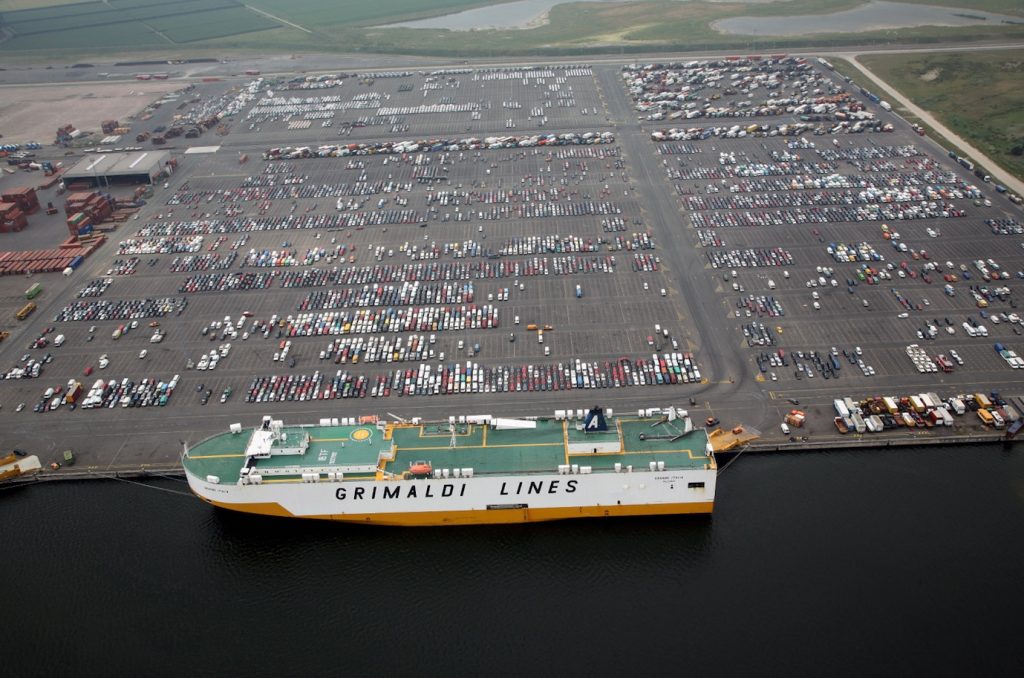 Forecasting matters for any organisation juggling costs and service levels, but in the finished vehicle sector, the stakes are higher than most
Forecasting matters for any organisation juggling costs and service levels, but in the finished vehicle sector, the stakes are higher than most
Generally speaking, it is easier to be prepared if you know what’s coming. Reliable demand forecasts help participants throughout the supply chain to ensure they have the materials, equipment, personnel and infrastructure in place to meet customer requirements. For the finished vehicle logistics sector, however, forecasting carries particular weight. That’s because transporting entire vehicles calls for specialised assets, from rail wagons and road transporters to huge, ocean-going pure-car-and-truck carriers (PCTCs) and distribution terminals. All of this transport and processing equipment is expensive, intended to be used for decades, and difficult to repurpose for other cargo when no longer needed to move or handle vehicles.
There is a strong economic incentive for the entire industry to improve the accuracy of short-, medium- and long-term forecasts. Underestimate demand, and carmakers struggle to get their products to consumers, while logistics providers lose out on business; overestimate it, and redundant capacity means higher costs and a likely fall in rates.
That’s the theory, but how does practice match up? In this publication over the years, many logistics executives have suggested that forecasting is a weak spot among OEMs and providers, or at least that it has not been able to match the inconsistencies in demand between markets, or end-of-month/quarter pushes. In a survey of around 20 senior logistics executives in our 10th anniversary issue, published October-December 2015, inaccurate and inconsistent forecasting and production planning were among the biggest headaches for most.
In this story...
In an era of increasingly sophisticated data mining and analysis, with the rise of new markets and the sharp volatility witnessed in both mature and emerging markets, forecasting should figure as a prominent investment and focus area for vehicle logistics providers. The verdict, however, is somewhat mixed, with some companies dedicating whole departments and considerable resources to modelling scenarios, while others still depend mostly on their customers and third parties. Regardless, few disagree over just how important forecasting is for the sector.
“Short-, medium- and long-term forecasts are essential for an FVL provider,” says Costantino Baldissara, commercial, logistics and operations director of family-owned shipping firm Grimaldi Group, and president of ECG, a lobby group representing vehicle logistics providers in Europe. “Only according to long-term forecasts can a shipping company take decisions about new tonnage investments, while short-term forecasts improve the efficiency of the daily business, thus enabling economic efficiencies that can be shared with clients or re-invested for clients’ interests.”
Short-term forecasts, which cover from as little as a week up to six months, help supply chain participants allocate capacity and adjust schedules for specific customers, vehicle types and trade lanes over the coming weeks and months. They also underpin financial performance predictions.
However, they can also be a source of great frustration for logistics providers. “[Impact from] short-term, bad forecasting is one of the main sources of waste in the supply chain, either through open space or costly solutions to provide extra space,” says Lars Arne Ramberg, global commercial manager at Höegh Autoliners, which runs a fleet of around 50 PCTC vessels in a global trade system (for more on Höegh). “The margins in the PCTC industry are under great pressure these days and operational efficiency is crucial.
“Big deviations in forecasts can become costly and the margins are not there to support such deviations,” he adds. “It is therefore important for us to cooperate closely with our customers on these matters, and to have an open and honest dialogue.”
For vehicle logistics providers, the most important sources of short-term forecast data are the OEMs themselves. After all, they have the latest information on vehicle sales and the best upstream view of their own actual production plans. For some logistics companies, OEM forecasts are the sole source of data used in their short-term planning. However, even for those providers, a single set of data is not enough to base operations upon. Konrad Zwirner, senior vice-president at Austria-based car carrier Hödlmayr International, notes that such forecasts must be supported with “fine tuning on weekly and daily levels” with OEM clients.
Even short-term customer forecasts can be subject to inaccuracy, and other companies point to the need to temper customer predictions with data from other sources. At Poland-based terminal operator and vehicle logistics specialist Adampol, for example, senior sales and marketing specialist Michal Mazur says such forecasts should be combined with observations on current market factors, and analyses of the “feasibility” and accuracy of those customers’ forecasts in previous months and quarters.

Some companies even find it advantageous to develop their own models of short-term demand. Lars Ramberg explains that Höegh creates statistical forecasts based on the actual historic volumes for a specific period and in a specific trade lane. “We then use various methods, mainly time series analysis, and apply the one that has the lowest error margin,” he says. “This is fed with base input from our customers and finally we evaluate the forecast vs. actuals for a given period.“
Medium settings
As companies shift their perspective to the medium term, between around six months and two years into the future, the need to incorporate perspectives beyond those of carmakers becomes an increasing priority. At shipping line and finished-vehicle transport specialist Wallenius Wilhelmsen Logistics (WWL), responsibility for operational and financial forecasting falls to Donal Duggan, vice-president of yield planning and performance, yield and tonnage planning, tonnage allocation, chartering and performance management. While short-term planning at WWL is almost entirely based on “bottom up” information from customers, he says, looking further out the company uses “top down” data comprised of market intelligence combined with, and building on, its 1-6 month forecast. “We are essentially extrapolating from our current position and our short-term forecast,” he says.
Many companies make use of commercial market research services, such as those provided by IHS Global Insight, as well as market outlooks provided by consultancies, trade associations and independent experts. The range of sources used for medium-term planning is diverse. At Adampol, for example, Michal Mazur lists trend analysis for specific markets and customers; sales plans from clients; contractual obligations; long-term plans from clients; and market studies from many sources, along with deep analysis of the changes in automotive industries and seasonal observations.
Indeed, notes WWL’s Duggan, as forecasting moves from the operational to the strategic, its value is “derived as much from the process and the discussions around the forecast assumptions as from the result.”
For many in the finished vehicle logistics sector, especially those with high-cost, long-lived assets, like ships or port terminals, long-term demand forecasts ranging from as little as two years to two decades are the most challenging – and yet they are strategically the most important effort. Long-term forecasting is “an important element in our strategic work, affecting capacity planning, new trade development and other investments,” says Teresa Lehovd, head of market intelligence at Höegh Autoliners.
Of course, looking far into the future is a difficult business, requiring the use of multiple data sources and different techniques to those applied in shorter time horizons. “In an uncertain and rapidly changing world, traditional statistical forecasting methods are no longer sufficient, as they all assume that the current relationships between factors influencing the future will remain the same,” continues Lehovd. For long-term forecasts, this is simply not the case anymore, she says, which has led companies like Höegh to look at other methods, such as ‘scenario planning’, a method that includes high-level simulations of possible outcomes.
At WWL, Donal Duggan points out that long-term forecasts also involve more variables than those for the short and medium term. “While our volumes can change rapidly in the short term the composition of our fleet does not. However, when we look at a 2- or even 30-year forecasts, there is scope for all changes in all elements of the business model.”
Accuracy assessments
Are forecasts reliable? There is general agreement that short-term forecasts are, broadly speaking, accurate enough to support everyday operations, although it depends widely on specific customers, regions and economic conditions. As WWL’s Duggan says: “No forecast is 100% accurate. Our short-term forecasts are accurate enough that we can sail highly utilised in tonnage while providing a high level of service for our customers.”
Other participants note that the quality of short-term forecasts can be dependent on the accuracy of customers’ own volume forecasts. “Some customers are very good at this and are on the spot, while others can improve,” notes Bjørn O. Gran Svenningsen, head of sales and marketing at European short-sea shipping operator UECC.
Höegh’s Lehovd agrees, adding that market conditions can make forecasting difficult for customers in some cases. “Forecast accuracy depends on the reliability of the systems our customers have and how well they plan their export activity,” he says. “It also depends on a trade lane. Typically, shipments between mature sourcing and destination areas are easier to predict than shipments to emerging markets.”
 When the global situation is stable, it may be possible to prepare quite accurate medium-term forecasts, says Adampol’s Mazur
When the global situation is stable, it may be possible to prepare quite accurate medium-term forecasts, says Adampol’s MazurMedium- and long-term forecasts are another matter, however. For WWL these forecasts are “a function of market sentiment,” says Duggan. Others note the impossibility of making accurate predictions in the face of large-scale economic volatility.
“The last decade has been full of crazy ups and downs, which affected maybe all markets,” says Costantino Baldissara. “The 2009 economic downturn affected all the world, but its intensity was different from one country to another.”
Most recently, he points to the uncertainty and volatility that the industry has faced from political turmoil in Arab countries, a marked slowdown in Israel and Turkey, and the impact of sanctions in Russia.
When the global situation is stable, it may be possible to prepare quite accurate medium-term forecasts, says Adampol’s Mazur, but the impact of events like the current crisis in Russia are impossible for almost anyone to predict – with perhaps the exception of governments in more direct control or influence over local markets.
Volatility challenges
Even where companies have robust, accurate short-term demand forecasts, day-to-day fluctuations can still disrupt capacity planning. Market seasonality makes deliveries difficult to manage, says Hödlmayr’s Konrad Zwirner, citing the UK’s twin March and September registration peaks as examples. Local commercial strategies can have an impact, too. “Some countries deliver up to 70% of the volume during the last days of each month,” he adds, “which again makes forecasting and operational performance a big challenge.”
Wolfgang Stöver, director of marketing and sales at BLG Automobile Logistics, notes that his company’s terminal at the port of Bremerhaven, Germany, may have to manage anything from two to seven vessels per day, which leads to significant demand volatility from day to day and shift to shift.
Höegh’s Ramberg adds that the precise model mix arriving from an OEM can also be difficult to predict, even in the short term. “This makes stowage planning challenging, because various car models may have different height and size, and if too high, they may not fit into normal car decks,” he says.
With the seeming increase in economic volatility around the world, how are forecasting techniques and approaches changing? Experts cite three main areas of evolution: data, markets and customer relationships.
Like so many other areas of the economy, demand forecasting is benefitting from the improved availability of data, and the processing power and analytical techniques necessary to make use of it. Both Höegh and Adampol, for example, have invested in bespoke, in-house systems to improve their internal planning and forecasting.
 While short-term forecasts improve the efficiency of the daily business, shipping companies need long-term forecasts to take decisions about new vessels
While short-term forecasts improve the efficiency of the daily business, shipping companies need long-term forecasts to take decisions about new vesselsBut if smarter systems make forecasts faster and easier to execute, there is little doubt that changes in global market conditions are making them more challenging to get right. “Technology will definitely be a vital enabler going forward,” says WWL’s Donal Duggan. “The ability and capability to make predictions will increase, but so will volatility and uncertainty. So our ability to forecast will be greater, but the bar will be set higher.”
“We believe forecasting will become more difficult,” agrees BLG’s Wolfgang Stöver. “Main streams are becoming minor streams, while new production streams are developing globally. Markets are rising and falling and consumer demand and consumer mentality are changing more dynamically.”
Increasing uncertainty is driving a fundamental shift in the nature of forecasting, says Duggan. “Uncertainty about the future leads to more uncertainty in the choices and strategies that are being implemented today. Whereas before forecasting may have been about confidently predicting the future, today it is far more about the dialogue around assumptions, forecasting within ranges and determining alternatives to possible unfolding scenarios.”
As they face increasing uncertainty, vehicle logistics providers are united in the view that closer, clearer communication with customers and other supply chain partners is a key factor. “The more providers are aware of clients’ plans, the more we can synchronise our firms to OEM targets, the more we can eliminate waste, the more we can pursue efficiencies to share, the more we can grow together.” says Costantino Baldissara.
What is important at a strategic level is equally critical on the operational front line. “Proactive communication among the planners and dispatchers is critical as good human relationships among the parties can solve a lot of operational challenges,” says Hödlmayr’s Konrad Zwirner.
Opinion is divided, however, on how well customers are able to provide the forecast information needed by their logistics partners to optimise planning. At BLG, Wolfgang Stöver is broadly satisfied. “Most of the OEMs have developed very good measures to provide us with data reflecting the volatility of our business,” he says.
Others are more circumspect. “If our customers underestimate their shipments, we will have a challenge to provide them with sufficient space on board,” says Höegh’s Lars Arne Ramberg. “On the other hand, if they overestimate, then we will sail with open space, and further reduce already stretched margins. With the rate levels we experience in the PCTC industry today, such downfalls are not sustainable in the long run.”
Hödlmayr’s Zwirner sums up this situation neatly. “Trust in forecasting is the key topic,” he says.
In practice, service providers have little choice but to invest in excess capacity to cover the inevitable uncertainty in their own forecasts and those of their customers. “Even relying on good forecasts, our philosophy is to invest in capacity and network synergies, allowing the utmost flexibility in terms of space and frequencies, and adapting our structure to the market demand in the fastest and most efficient way,” says Grimaldi’s Baldissara.
However, “flexibility comes with a cost tag,” points out Lars Arne Ramberg, “and we need to find that perfect balance between the level of flexibility required by our customers and the cost appetite they have.”
Right now, some service providers feel that those costs fall disproportionately on their shoulders. “It cannot be a fair business attitude that the client orders capacities from suppliers, then changes the demand practically permanently until the last day of execution without any compensation for the supplier,” concludes Konrad Zwirner. “It is understood that a logistics supplier defines the management of volatility as a core business, but this competence should also have a value.”


































